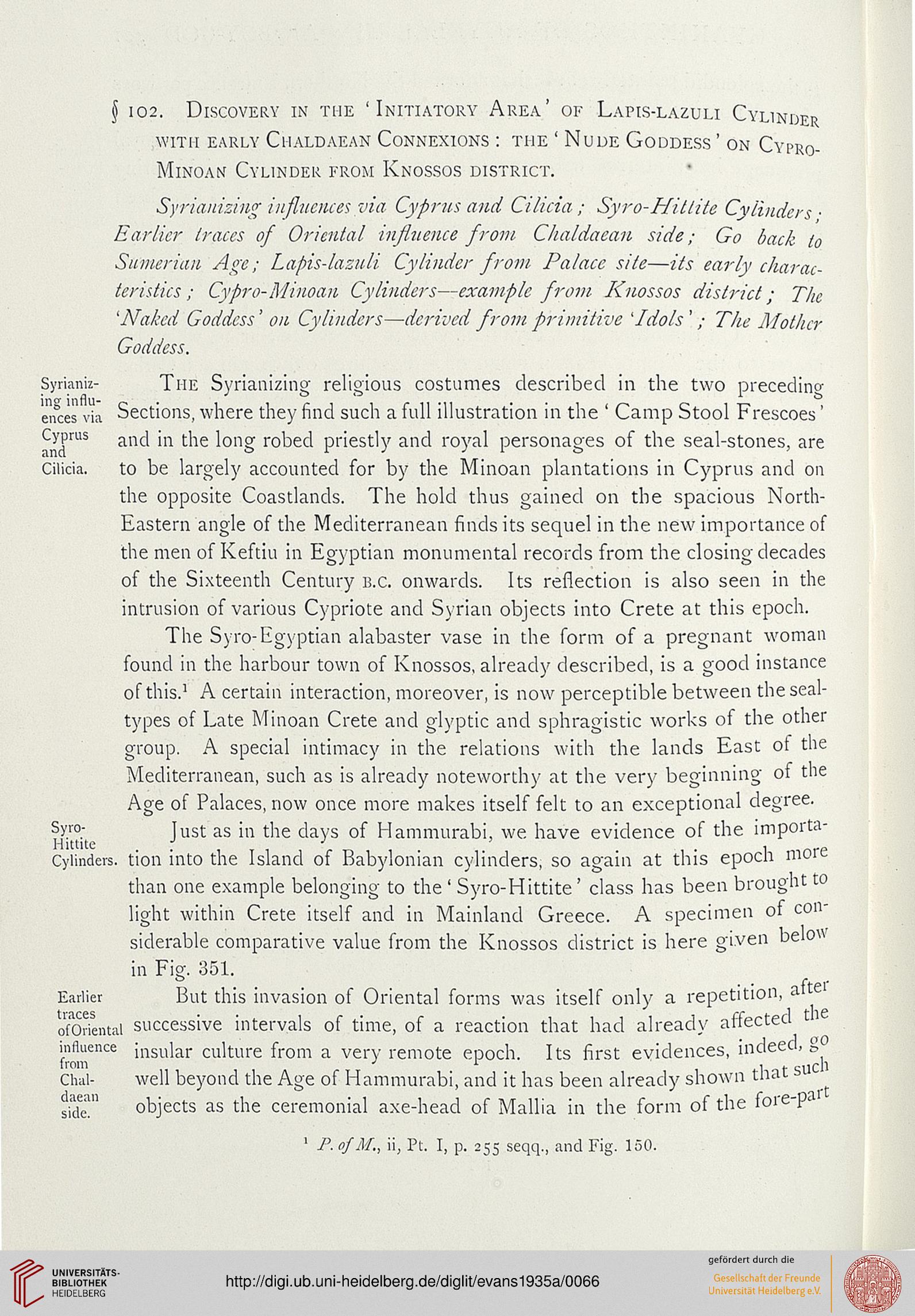I 102. Discovery in the 'Initiatory Area' of Lapis-lazuli Cylinder
WITH EARLY ClIALDAEAN CONNEXIONS : THE ' NuDE GODDESS ' ON Cyprq-
Minoan Cylinder from Knossos district.
Syriauizing influences via Cyprus and Cilicia; Syro-Hitlite Cylinders ■
Earlier traces of Oriental influence from Chaldaean side; Go back to
Sumeriau Age; Lapis-lazuli Cylinder from Palace site—its early charac-
teristics ; Cypro-Minoan Cylinders—example from Knossos district; The
'Naked Goddess' on Cylinders—derived from primitive 'Idols '; The Mother
Goddess.
Syrianiz- The Syriauizing religious costumes described in the two precedino-
ences via Sections, where they find such a full illustration in the ' Camp Stool Frescoes'
Cyprus anci ;n tile i011g j-Qbed priestly and royal personages of the seal-stones, are
Cilicia. to be largely accounted for by the Minoan plantations in Cyprus and on
the opposite Coastlands. The hold thus gained on the spacious North-
Eastern angle of the Mediterranean finds its sequel in the new importance of
the men of Keftiu in Egyptian monumental records from the closing" decades
of the Sixteenth Century B.C. onwards. Its reflection is also seen in the
intrusion of various Cypriote and Syrian objects into Crete at this epoch.
The Syro-Egyptian alabaster vase in the form of a pregnant woman
found in the harbour town of Knossos, already described, is a good instance
of this.1 A certain interaction, moreover, is now perceptible between the seal-
types of Late Minoan Crete and glyptic and sphragistic works of the other
group. A special intimacy in the relations with the lands East of the
Mediterranean, such as is already noteworthy at the very beginning of the
Age of Palaces, now once more makes itself felt to an exceptional degree.
s)™." lust as in the clays of Hammurabi, we have evidence of the importa-
Hittitc
Cylinders, tion into the Island of Babylonian cylinders, so again at this epoch more
than one example belonging to the ' Syro-Hittite' class has been brought to
light within Crete itself and in Mainland Greece. A specimen of con-
siderable comparative value from the Knossos district is here given oeio
in Fig. 351.
Earlier But this invasion of Oriental forms was itself only a repetition, a
ofOrierital successive intervals of time, of a reaction that had already affected
influence insular culture from a very remote epoch. Its first evidences, indeed, 0
Chal- well beyond the Age of Hammurabi, and it has been already shown that s
side™ objects as the ceremonial axe-head of Mallia in the form of the foie-p
' }'. of M., ii, Pt. I, p. 255 seqq., and Fig. 150.
WITH EARLY ClIALDAEAN CONNEXIONS : THE ' NuDE GODDESS ' ON Cyprq-
Minoan Cylinder from Knossos district.
Syriauizing influences via Cyprus and Cilicia; Syro-Hitlite Cylinders ■
Earlier traces of Oriental influence from Chaldaean side; Go back to
Sumeriau Age; Lapis-lazuli Cylinder from Palace site—its early charac-
teristics ; Cypro-Minoan Cylinders—example from Knossos district; The
'Naked Goddess' on Cylinders—derived from primitive 'Idols '; The Mother
Goddess.
Syrianiz- The Syriauizing religious costumes described in the two precedino-
ences via Sections, where they find such a full illustration in the ' Camp Stool Frescoes'
Cyprus anci ;n tile i011g j-Qbed priestly and royal personages of the seal-stones, are
Cilicia. to be largely accounted for by the Minoan plantations in Cyprus and on
the opposite Coastlands. The hold thus gained on the spacious North-
Eastern angle of the Mediterranean finds its sequel in the new importance of
the men of Keftiu in Egyptian monumental records from the closing" decades
of the Sixteenth Century B.C. onwards. Its reflection is also seen in the
intrusion of various Cypriote and Syrian objects into Crete at this epoch.
The Syro-Egyptian alabaster vase in the form of a pregnant woman
found in the harbour town of Knossos, already described, is a good instance
of this.1 A certain interaction, moreover, is now perceptible between the seal-
types of Late Minoan Crete and glyptic and sphragistic works of the other
group. A special intimacy in the relations with the lands East of the
Mediterranean, such as is already noteworthy at the very beginning of the
Age of Palaces, now once more makes itself felt to an exceptional degree.
s)™." lust as in the clays of Hammurabi, we have evidence of the importa-
Hittitc
Cylinders, tion into the Island of Babylonian cylinders, so again at this epoch more
than one example belonging to the ' Syro-Hittite' class has been brought to
light within Crete itself and in Mainland Greece. A specimen of con-
siderable comparative value from the Knossos district is here given oeio
in Fig. 351.
Earlier But this invasion of Oriental forms was itself only a repetition, a
ofOrierital successive intervals of time, of a reaction that had already affected
influence insular culture from a very remote epoch. Its first evidences, indeed, 0
Chal- well beyond the Age of Hammurabi, and it has been already shown that s
side™ objects as the ceremonial axe-head of Mallia in the form of the foie-p
' }'. of M., ii, Pt. I, p. 255 seqq., and Fig. 150.





